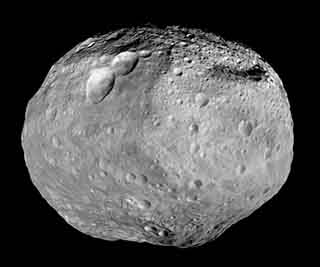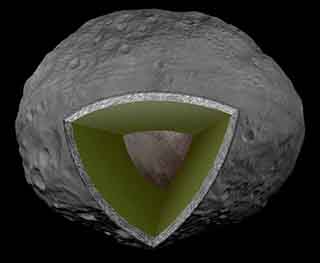Vesta
Vesta is a large asteroid, the second largest object in the Asteroid belt.

Composite image of Vesta taken by Dawn spacecraft
Credit: NASA
Facts About Vesta:
- Vesta comprises approx 9% of the mass of the asteroid belt.
- The brightest asteroid visible from Earth. Occasionally visible to the naked eye from dark skies.
- Was orbited by NASA's Dawn spacecraft from 16 July 2011 to September 5, 2012.
- Has an iron core about 110 km in radius, suggesting that Vesta was molten in its early history, allowing iron to sink into a core and produce a basaltic crust.
- Surface is covered by regolith.
- Rheasilvia crater, near the south pole, is 505 km in diameter.
- Surface temperature varies between -20 °C and -190 °C.
- One of only 6 known Solar System bodies for which we have physical samples on Earth.
- Located in the inner asteroid belt inside the Kirkwood gap at 2.50 AU.
Classification: Asteroid (orbiting Sun)
Names: Vesta
Discovered: 1807 by Heinrich Wilhelm Olbers
Naming: Vesta, the Roman goddess of the hearth, home, and family
Magnitude: 5.1000 (app) 3.2000 (abs)
Albedo: 0.4230
Surface Gravity: 0.0250 g
Escape Velocity: 0.3600 km/s
Adjective: Vestan, Vestian

Innermost core (brown), mantle (green) and crust (gray).
Credit: NASA/JPL-Caltech
